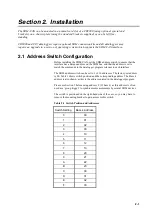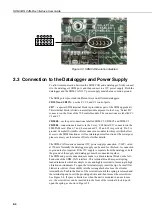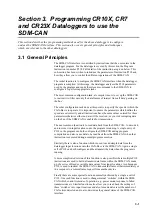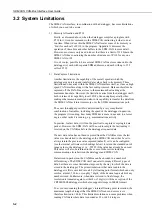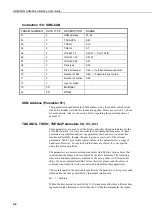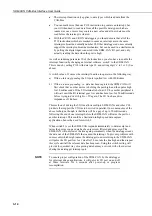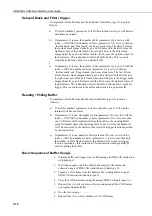
Section 3. Programming CR10X, CR7
and CR23X Dataloggers to use the
SDM-CAN
This section describes the programming methods used for the above dataloggers to configure
and use the SDM-CAN Interface. This section also covers general principles and techniques
which are relevant to the other dataloggers,
3.1 General Principles
The SDM-CAN interface is controlled by instructions that the user enters in the
datalogger program. For the dataloggers covered by this section the Program
Instruction is number P118. Full details of the instruction are given below. This
sub-section has been written to introduce the parameters of Instruction P118 and
how they allow you to control the different operations of the SDM-CAN.
The initial function is to configure the SDM-CAN interface when the datalogger
program is compiled. At this stage, the datalogger analyses the P118 parameters
used by the program and sends the relevant commands to the SDM-CAN to
configure it to perform appropriate tasks.
The most common configuration task, at compile time, is to set up the SDM-CAN
to instruct it to filter out only the data frames of interest from all data ‘passing on
the bus’.
The other configuration task done at this point is to specify the speed at which the
CAN-Bus is to operate. It is important to ensure the parameters which define the
speed are set correctly and all instructions have the same values entered for these
parameters otherwise either no data will be received, or you risk corrupting data
on the bus, if the SDM-CAN is enabled for transmission.
The next common function is to read data back from the SDM-CAN, to decode it,
and to store it in input locations once the program is running. A single entry of
P118 in the program can both configure the SDM-CAN during program
compilation and also cause data to be read back from the SDM-CAN when that
instruction is executed during normal program execution.
Similarly there is also a function which is used to send simple data from the
datalogger input locations onto the CAN-Bus via the SDM-CAN. Again a single
call of P118 can both configure and then transmit the data when the program is
running.
A more complicated version of this function is also possible where multiple P118
instructions are used to build a transmit data frame within the SDM-CAN, made
up of a series of fixed or variable data values from input locations. A subsequent
P118 is used to instruct the SDM-CAN to transmit the frame either immediately or
in a response to a remote frame request from another device.
Finally there are some special functions normally achieved by a single a call of
P118. One such function is used to change internal ‘switches’ within the SDM-
CAN which control its mode of operation, e.g. power mode, response to failed
transmissions etc. Similar functions also allow you to read back the settings of
these ‘switches’ into input locations and also to read and/or reset the number of
CAN errors detected and to also determine the general status of the SDM-CAN
interface.
3-1







